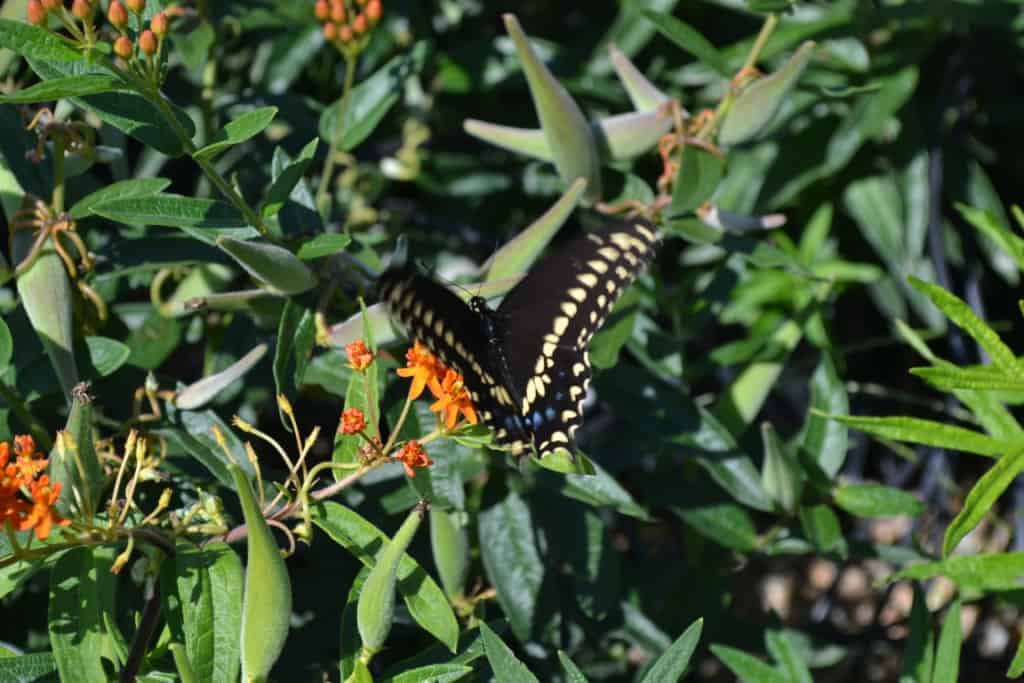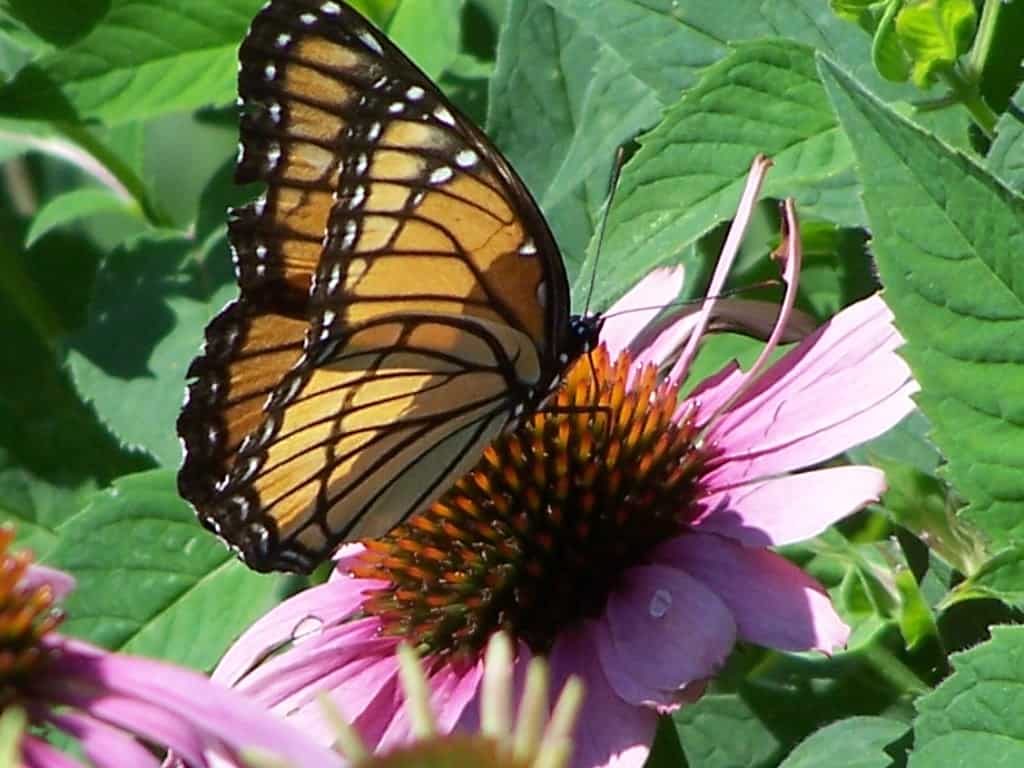by Nadine Champlin, Landscape Designer, Owner of Prairie Place Designs, Sabetha, KS
Design Consultant for Grimm’s Gardens, Hiawatha, KS
Why have a butterfly garden?
A Native American legend tells us: “If you have a secret wish, find a butterfly and whisper your wish to it. When you release the butterfly it will carry your wish to the Great Spirit. Because you have not harmed the butterfly and upset the balance of nature, the Great Spirit will grant you your wish.”

We all love to watch butterflies flit among the flowers; they have been called “flying flowers” because of their beauty! Butterflies are indeed messengers of nature, maybe not actually speaking to the Great Spirit as the legend says, but they reveal how healthy an environment is. They are only where no pesticides or pollution are present since they are very sensitive to toxins. They provide a balance in nature since they are important pollinators, and do not sting, bite or transmit disease, and they provide a food source for birds and animals (a good reason to not place your butterfly garden in a bird feeding area!). Birds would rather feast on butterflies than bird seed.
How to attract butterflies
In order to attract a butterfly you must think like a butterfly! First, you must understand what makes butterflies unique: the miracle of complete metamorphosis. Butterflies begin as a tiny egg, and then hatch into a tiny caterpillar with chewing mouth parts. Then they grow and develop into a cocoon and emerge as a six-legged insect: an adult butterfly with sucking mouth parts. What a delight to watch this miracle in a glass jar and release the adult butterfly into the world!
Unlike moths, butterfly larvae feed on herbs and flowering plants (dill, parsley, thistle, milkweed, goldenrod, rotting fruit). They eat through a feeding tube like a straw and suck nectar from flowers. One of the most interesting butterflies is the Monarch, which migrates to the US from the high mountains west of Mexico City. Check out their life cycle at www.monarchbutterflyusa.com.
Components of a butterfly garden
A butterfly garden must contain 4 components: a sunny location, protection from predators, food and water.
1. Sunny Location – It is important to design your garden around the sun and wind. All their activities are oriented around the sun: they bask in the sun, navigate by the sun, eat plants that grow in full sun, and their body temperatures are regulated by the sun. Incorporate boulders in your garden for places they can “sun” themselves.
2. Protection – Trees and grasses provide protection from birds and shelter from the rain.
3. Food – A variety of plants that bloom at different times is necessary to provide butterfly food all summer. Arrange them stair-step fashion to take advantage of the sun. Different species of butterflies have different preferences of nectar. They need high energy food (sugar) so they can fly and search for more food. Phlox plants provide many flowers in one area so this provides them much nectar and they don’t have to travel far. Butterflies have compound eyes that allow them to see in all directions without turning their head. They are nearsighted, like most insects, so they are attracted to masses of flowers. They have a well-developed sense of smell from their antennae, which are club-shaped (moths are feathery). So plant fragrant flowers. They like plants they can easily land on, so provide plenty of landing pads such as coneflowers, daisies & zinnias.
4. Water – Butterflies need a source of shallow water. They have thousands of shingle-like scales attached to wing membranes. If you rub your finger across a butterfly wing the scales brush off like dust. If their wings get wet they cannot fly away from predators so it is important to use a shallow dish like a pie tin and place rocks in it for them to land on. Fill the dish half-full just to barely cover the rocks. Rinse weekly to provide them a fresh source of water. Males will congregate at small rain puddles as men do at coffee houses!
Here is an example of a Butterfly Garden Design:
Plant species that will attract the butterflies you want to observe:
Some of the most common Kansas butterflies and their favorite food are:
Swallowtails have a well-developed wing appendage (tail) extending from the rear edge of each hind wing. Their larva feed on lilac, ash & birch. The adult feeds on honeysuckle, milkweed, lilac, & goldenrod.
Brush-footed Butterflies (Hackberry Butterfly, Question Mark, Red Admiral, Viceroy, Fritillary) – Larva feed on violets, hollyhocks, willow, & apple. The adult feeds on rotting fruit, goldenrod, milkweed, aster, zinnia, butterfly bush.
Sulphurs & White – Common in fields and yards with clover. They also feed on Partridge Pea & related legumes.
Blues & Hairstreaks appear as small versions of swallowtails. At rest they hold their wings folded and display patches of orange spots. Birds will strike at these color patches mistaking them for butterfly heads allowing them to escape. The Juniper Hairstreak is one of Kansas’ most attractive butterflies. They are usually found on and around cedar trees. They are olive green with bands of cinnamon brown edged in white.
Milkweed Butterflies (Monarch & Viceroy) feed primarily from the milkweed plant. Find out more about Monarch butterflies with our article “Creating a Monarch Waystation”
Skippers are identified by a swift bouncing flight pattern and a stout body with distinctive hooks at the ends of antennae. They are the most numerous butterfly family in Kansas. The host plant for them are various grasses, and they commonly visit flowers in the native prairie. Males appear to establish territories.
Obtain a pocket guide to Common Kansas Butterflies by Jim Mason. You will be amazed at the insects you will observe while looking for butterflies. The world of insects is fascinating to explore.
Benefits of a butterfly garden
Butterfly gardening is a way of using your yard for conservation purposes. Your garden becomes a safe haven for butterflies. As our population continues to grow we place more pressure upon the land for food, living and working space. This demand has caused a loss of natural vegetation (habitat). Start your own butterfly haven and watch miracles happen!
If you have children, creating a butterfly garden is an excellent way to get them outside and learning about nature. Check out more ideas with our articles: “Plants for Children’s Gardens” “Bringing Children Outside” and “Create a Nature Garden for Children”
Stop in to Grimm’s Gardens and pick up all the butterfly plants you need! If you live out of the area, shop our online store to find butterfly plants!




